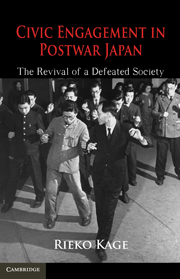Book contents
- Frontmatter
- Contents
- List of Tables
- List of Figures
- Preface
- Acknowledgments
- Civic Engagement in Postwar Japan
- 1 Introduction
- 2 Civic Engagement: The Dependent Variable
- 3 War and Civic Engagement: A Theoretical Framework
- 4 Quantitative Analysis: The Rise of Civic Engagement across Forty-Six Japanese Prefectures
- 5 The Long-Term Effects of Wartime Mobilization: Cross-National Analysis
- 6 Repression and Revival of the YMCA Japan
- 7 Wartime Endorsement and Postwar Repression of a Traditional Art
- 8 Civil Society and Reconstruction in Postwar Japan
- 9 Conclusions
- References
- Index
2 - Civic Engagement: The Dependent Variable
Published online by Cambridge University Press: 06 December 2010
- Frontmatter
- Contents
- List of Tables
- List of Figures
- Preface
- Acknowledgments
- Civic Engagement in Postwar Japan
- 1 Introduction
- 2 Civic Engagement: The Dependent Variable
- 3 War and Civic Engagement: A Theoretical Framework
- 4 Quantitative Analysis: The Rise of Civic Engagement across Forty-Six Japanese Prefectures
- 5 The Long-Term Effects of Wartime Mobilization: Cross-National Analysis
- 6 Repression and Revival of the YMCA Japan
- 7 Wartime Endorsement and Postwar Repression of a Traditional Art
- 8 Civil Society and Reconstruction in Postwar Japan
- 9 Conclusions
- References
- Index
Summary
OVERVIEW
As noted in Chapter 1, little empirical data outside of the United States have thus far been compiled on the changes in the trajectory of civic engagement in the wake of wars. Chapter 1 further explained why collecting data on the case of mid-twentieth-century Japan would be especially useful as a test of the standard victory/defeat hypothesis.
What in fact happened to levels of civic engagement in Japan in the wake of defeat? How do the postwar levels of voluntary participation compare with the prewar period? This chapter presents the results of an original mining of Japanese voluntary association and government archives. Much of the data presented in this chapter have never been systematically compiled, either in the Japanese or English language.
Drawing on these data, the chapter advances five main claims:
1) In absolute terms, levels of membership grew to much higher levels in the postwar period compared to the prewar period. The available data generally exhibit a sharp rise in memberships during the first postwar decade, even before Japan's economic “takeoff” began around the early to mid-1950s.
2) Levels of postwar membership growth were at least as rapid for associations that operated under fairly liberal conditions during the prewar and wartime periods as those that had been more repressed.
3) In the immediate postwar era, membership in groups with more “indigenous” Japanese origins appears to have risen at rates that are comparable with groups with more “Western” origins.
4) There is some evidence that associations that were suppressed by the U.S. occupation exhibited less rapid increases in memberships compared to those that were not; but in either case, by 1955, membership appears to have grown in absolute terms.
[…]
- Type
- Chapter
- Information
- Civic Engagement in Postwar JapanThe Revival of a Defeated Society, pp. 19 - 43Publisher: Cambridge University PressPrint publication year: 2010

